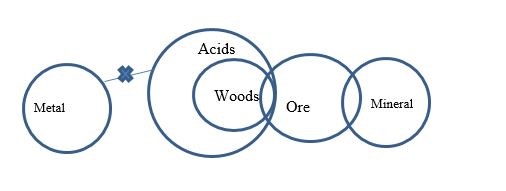Question
Statement : Some minerals are ores. Some ores
are woods. All woods are acids. No acids is a metal. Conclusion : I. Some acids are minerals. II. Some metals are not woods. III. Some metals are ores. IV. Some acids may not be woods. In each of the questions below are given four statements followed by four conclusions numbered I, II and III and IV. You have to take the given statements to be true even if they seem to be at variance with commonly known facts. Read all the conclusions and then decide which of given conclusions logically follows from the given statements disregarding commonly known facts.Solution
I + I =No conclusion. Hence, conclusion I will not follow. All woods are acids (A) + No acid is a metal (E) ⇒ No wood is a metal (E) ⇒ Conversion ⇒ Some metals are not woods (O) . Hence, conclusion II follows. Some ores are woods (I) + All woods are acids (A) ⇒ Some ores are acid (I) + No acid is a metal (E) ⇒ Some ores are not metals (O).Hence, conclusion III will not follow. All woods are acids (A) ⇒ Conversion ⇒ Some acids are woods (I) ⇒ Probable conclusion ⇒ Some acids may not be woods (O). Hence, conclusion IV follow. ALTERNATE SOLUTION: Relevant Minimal Possibility: 
Statements:Some combs are boxes.
All boxes are mirrors.
Conclusions:I. Some boxes are combs.
II. Some mirrors are combs.
Statements: All medicine are tablets.
All pills are tablets.
All tablets are tonics.
Conclusions: I. All medicine are tonics. ...
Statement:
Only a few Heel is Sandal
All Sandals are Laces
Only Lace is buckle
Conclusion:
I. Some Heels are Lac...
Statements:
Only a few Laptops are Notebooks.
No Notebook is Computer.
Only a few Notebooks are Bars.
Only a few Bars...
In the question below are given some statements followed by some conclusions. You have to take the given statements to be true even if they seem to be ...
Three statements are given, followed by three conclusions numbered I, II and III. Assuming the statements to be true, even if they seem to be at varia...
Statements:
Some Facebook are Reels.
All Meta are Reels.
Only a few Reels are Views.
Conclusions:
I. All Reels ...
Read the given statements and conclusion carefully. Assuming the information given in the statement is true, even if it appears to be at variance with...
Statements:
Some chalks are wires.
No wire is pole.
Some poles are irons .
Conclusions:
I. No pole is a wire.
...Conclusions:
Some pens are pencil.
No pencil is black.
Statements:
Relevant for Exams:



